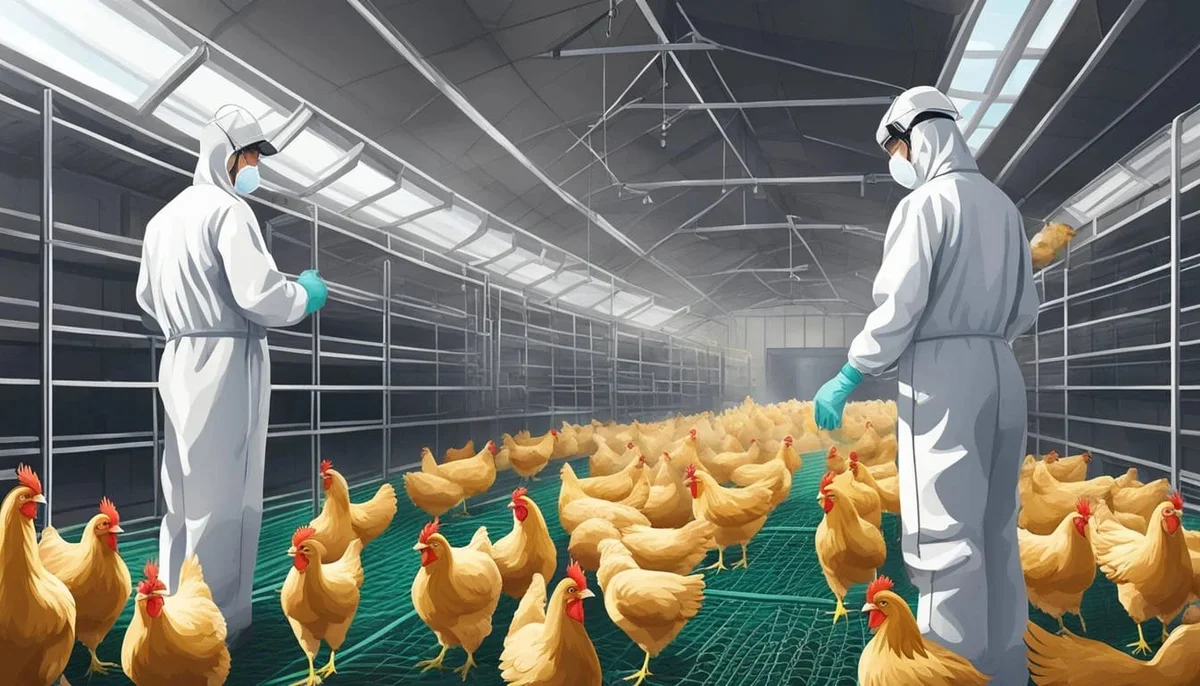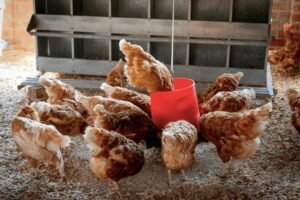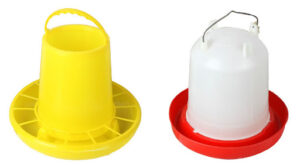For folks like us in the poultry business, a single sick bird can be the sign of a much bigger problem. A disease outbreak is more than just a setback; it’s a threat to your entire livelihood and the welfare of your flock. The financial and emotional cost can be devastating. This is where a strong poultry farm biosecurity plan comes in. Biosecurity in poultry farms isn’t just a set of rules—it’s a mindset backed by daily, documented biosecurity measures for poultry that keep pathogens off your farm and out of your houses.
This guide will walk you through, step-by-step, how to develop a biosecurity plan based on hard lessons learned in the field. It’s both robust and practical for your specific operation.
The Main Goal and Purpose of a Biosecurity Plan
The main goal of biosecurity is simple: to prevent the introduction and spread of disease-causing organisms onto your farm. It’s the best insurance policy you can have for your flock health. The primary objectives are:
- Disease Prevention: To protect your flock from common and devastating diseases like Avian Influenza (H5N1), Newcastle Disease, Infectious Bronchitis, and Salmonella. A single outbreak can lead to losing your entire flock. For a deeper dive into disease specifics, government resources like the USDA’s guide on avian influenza are invaluable for understanding the stakes.
- Protecting the Food Supply: Healthy birds contribute to a safe and stable food chain. We are on the front lines of public health, and good biosecurity prevents contaminants from ever reaching the market.
- Ensuring Farm Profitability: A healthy flock is a productive flock. In my experience, preventing disease is far cheaper than treating it. It reduces mortality rates, improves growth in broilers and egg production in layers, and lowers veterinarian costs—all of which are essential for a profitable poultry business in Nigeria.
- Promoting Animal Welfare: A good biosecurity plan is a fundamental part of ethical farming. It ensures your birds live in a clean, safe, and healthy environment.
With a clear understanding of the “why,” let’s break down the core principles that form the foundation of any effective plan.
The Fundamentals: Understanding the 3 Components of a Biosecurity Plan
To build an effective plan, it’s helpful to think about biosecurity in three distinct parts. This framework, recognized by global bodies like the Food and Agriculture Organization (FAO), helps ensure you cover all your bases.
1. Conceptual Biosecurity (The Plan)
This is the strategic planning phase. A hard lesson I learned early on was that you can’t fix a bad location with good operations. Getting this right from the start saves a world of trouble. Key considerations include:
- Site Location: Choose a location that is isolated from other poultry farms and waterways used by migratory waterfowl, which are known carriers of avian influenza.
- Farm Layout: Design the farm for a logical, one-way flow of traffic. The hatchery and brooding areas, where your youngest birds are, should always be in the most protected, upwind part of the farm.
- Sourcing Birds: It is crucial to source your chicks from reputable, disease-free hatcheries. Trust me on this, a cheap chick can be the most expensive purchase you ever make. In the U.S., I only work with hatcheries that are part of the National Poultry Improvement Plan (NPIP) or your country’s official certification program. Outside the U.S., use hatcheries certified by your national poultry health program and demand written vaccination/health declarations with each shipment.
2. Structural Biosecurity (The Farm Setup)
This refers to the physical barriers you put in place. Think of it as the fortress you build around your flock.
- Perimeter Fencing: Your first line of defense. It controls farm access, keeps out stray animals, and is a key part of predator-proofing 101. It also manages unauthorized people and vehicle traffic.
- Secure Housing: Prefer impermeable, easy-to-clean floors (concrete or sealed surfaces). If that’s not feasible, use heavy plastic liners beneath litter to improve cleaning and disinfection. The key is preventing pathogens from seeping into the ground. Seal every crack. On our farm, we’ve found that a tiny opening is an open invitation for rodents and wild birds.
- Proper Drainage: Standing water is a breeding ground for trouble. Ensure your site is graded so water drains away from poultry houses.
- Dedicated Facilities: For large commercial farms, designated shower-in/shower-out facilities are ideal. For smaller farms, this level of biosecurity can be achieved with a strict “Danish entry system” (a bench entry) combined with dedicated house boots/boot covers and disposable coveralls for anyone entering the housing area.
3. Operational Biosecurity (The Daily Routine)
This is where the plan comes to life. On our farm, we’ve found that the most common mistake is a simple breakdown in daily routine, especially when people are in a hurry. It includes all the daily procedures and SOPs (Standard Operating Procedures) that you and your staff follow.
- People Management: All farm staff must be trained to avoid contact with outside poultry. A strict visitor policy, managed with a logbook, is non-negotiable. Require a 48–72-hour downtime after contact with other poultry before entering the PBA/LOS.
- Equipment Protocols: Dedicate tools to specific houses whenever possible. Anything shared must be scrubbed and disinfected before moving between houses.
- Litter and Mortality Management: Handle used litter management and dead birds carefully. Prompt and safe disposal is critical. Acceptable methods include on-farm composting, rendering, incineration, or burial where it is legal and follows local regulations. Always maintain a detailed mortality log.
These three components provide the “what” of biosecurity. Now, let’s translate these concepts into a concrete, actionable plan.
How to Develop and Implement Your Farm Biosecurity Plan: A Step-by-Step Guide
Here is a practical, step-by-step approach to creating a plan tailored for your farm.
Step 1: Create a Farm-Specific Biosecurity Map
Draw a simple map of your farm. Use colors and industry terms to clearly define your zones:
- Perimeter Buffer Area (PBA): This is the outer controlled zone of your farm. Parking, deliveries, and employee vehicles should stay within this area, outside the production block.
- Transitional Zone: The area where people and equipment must undergo disinfection before proceeding. This is where you’d have shower facilities, changing rooms, and vehicle disinfection stations.
- Restricted/Clean Area: The poultry houses and production areas. Access is strictly limited. Mark the location of all gates, doors, footbaths, and hand sanitizing stations.
Step 2: Establish a Clear Line of Separation
On your map, draw a bold Line of Separation (LOS) between the transitional and clean zones. This is not an imaginary line. It must be enforced with a physical barrier. Post ‘Biosecure Area,’ ‘LOS—No Entry,’ and ‘PPE Required’ signs at each house and gate. A simple bench—the “Danish entry system”—is a great physical reminder. You sit on the bench, take off your “dirty” boots, and swing your legs over to put on dedicated “clean” farm boots.
Step 3: Implement Strict Access Control for People and Vehicles
Your farm should have a single, controlled entry point.
- Logbook and Visitor Downtime: Everyone who enters must sign in. Crucially, your policy must require that anyone with recent contact with other poultry observe a “downtime” period of 48–72 hours before visiting your farm.
- Vehicle Disinfection: Keep vehicles outside the PBA when possible. If entry is unavoidable, apply a labeled disinfectant via low-pressure spray to tires/wheel wells at correct dilution and contact time; log each application.
- Visitor Policy: Visitors must wear farm-provided personal protective equipment (PPE). No exceptions. Stock disposable coveralls, boot covers/house-specific boots, gloves, and hair/beard covers by size at each entry point.
Step 4: Develop Protocols for Flock Health and New Stock
- Quarantine: All new birds are kept in isolation for at least 30 days. This has saved us from disaster more than once.
- Vaccination: Work with your veterinarian to develop a robust vaccination schedule.
- Daily Health Checks: Perform daily health checks. You know your birds better than anyone. Look for signs of illness or a drop in feed and water consumption.
Step 5: Master Cleaning, Disinfection, and Pest Control
A professional cleaning and disinfection (C&D) process is non-negotiable between flocks: Dry Clean, Wet Wash, Rinse, and Disinfect. For disinfectants, use a reputable product like Virkon S and always follow the label. After Disinfect, schedule a minimum 10–14 days of downtime where practical. Validate effectiveness periodically (ATP testing or environmental swabs).
Step 6: Ensure Feed and Water Safety
- Water Lines: Some farmers use apple cider vinegar as a feed supplement, but it is not a sanitizer. Maintain a labeled sanitizer program for waterlines (e.g., stabilized hydrogen peroxide/chlorine per label), plus periodic shock and flush.
- Water Source: Test your water at least once a year.
- Feed Storage: Use sealed, rodent-proof bins. A feed spill is a dinner bell for pests.
Step 7: Train Your Team: The Code of Conduct for Biosecurity
Your plan is only as strong as your people.
- Formal Training: Train all new hires and hold annual refreshers.
- Visual Aids: Post simple reminders in key areas.
- Lead by Example: If the boss cuts corners, so will everyone else. Follow every protocol, every day.
The consensus among poultry health experts is that the most common biosecurity failure isn’t a lack of expensive equipment, but a simple breakdown in daily routine. Consistency is everything.
These steps form the core of your daily operations. To make sure nothing is missed, let’s turn this into a checklist.
Your Poultry Farm Biosecurity Checklist: The 5 Pillars in Action
📋 Download Our Complete Biosecurity Audit ChecklistGet our printable one-page Poultry Farm Biosecurity Checklist PDF to conduct thorough audits of your operation. Print it, laminate it, and use it quarterly to ensure compliance.Download Checklist (PDF)
Use this poultry farm biosecurity checklist to review your operations. These 5 pillars of biosecurity are the foundation of a successful program.
Pillar 1: Isolation & Traffic Control
- Secure perimeter fence with a lockable gate.
- Single, controlled entry point for all traffic.
- Visitor logbook maintained, enforcing 48-72 hour downtime.
- Functional system for vehicle tire disinfection.
- Separate quarantine facility for all new birds.
Pillar 2: Flock Health Management
- Source birds exclusively from reputable hatcheries.
- Written vaccination plan developed with a veterinarian.
- Sick birds immediately removed. If you’re asking, “why is my chicken lethargic,” this guide can help. Mortality log kept and analyzed.
- Monitor feed/water consumption and mortality rates daily. Track feed/water per 1,000 birds/day and mortality; sudden deviations trigger a biosecurity check.
Pillar 3: Cleaning & Disinfection
- Footbaths used correctly at every house entrance (clean boots first, then disinfect). Footbaths kept free of debris and replaced at least daily.
- Clean, farm-dedicated PPE required and used by everyone entering a poultry house.
- Strict “all-in/all-out” system followed.
- Full C&D process, including a 10-14 day downtime, completed between flocks.
Pillar 4: Pest & Rodent Control
- Feed stored in sealed, pest-proof containers.
- Active and documented rodent baiting/trapping program.
- Houses sealed to prevent wild bird entry.
- Insect control program in place for pests like darkling beetles, including managing litter moisture and rotating insecticides.
- Vegetation-free perimeter (~3 feet) maintained around houses; mow/trim to reduce harborage.
Pillar 5: Auditing & Training
- All staff have completed biosecurity training.
- Formal biosecurity self-audits conducted quarterly for compliance.
- Biosecurity SOPs are written and accessible.
- Stay informed about regional disease threats through sources like the USDA or the World Organisation for Animal Health (WOAH).
- Maintain logs for visitors, vehicle disinfection, footbath changes, rodent bait checks, waterline sanitation, and C&D cycles.
While these daily practices are essential, modern technology offers powerful tools to make our jobs easier.
What Role Does Technology Play in Modern Biosecurity?
Technology is a great partner in biosecurity.
- Environmental Control: Automated climate control and ventilation systems help control airborne pathogens.
- Smart Sensors: Sensors that monitor water and feed consumption can give you the earliest possible warning of a problem.
- Digital Record-Keeping: Apps make it easier to track visitors, monitor flock data, and conduct audits. Many of these tools fall under the umbrella of precision livestock farming, which uses data to make management more efficient and responsive.
- Remote Surveillance: Cameras let you check on your flock without entering the houses, reducing contamination risk.
Even with the best plans, you have to be prepared for the worst.
Creating Your Emergency Disease Response Plan
Hope is not a strategy. If you suspect an outbreak, you need a pre-prepared plan.
Immediate Actions: The First Few Hours are Critical
- Isolate the Area: Immediately restrict all access to the affected house.
- Stop All Movements: Halt all traffic—people, birds, equipment—on and off the farm.
- Contact Your Veterinarian: This is your first and most important phone call. Knowing when to call the vet for a backyard chicken is a critical skill.
Communication Protocol: Who to Call and When
Have a list of emergency contacts ready. Keep contacts for your vet and your state/provincial animal health authority (e.g., State Veterinarian in the U.S.; DEFRA in the U.K.).
Movement Control: Locking Down the Farm
Cooperate fully with officials. They will establish a control zone, and following their rules is crucial to protect the entire region.
Having a response plan is a critical part of biosecurity. Now let’s address some common questions.
Frequently Asked Questions About Poultry Biosecurity
What is the simplest form of biosecurity?
Controlling what comes onto your farm. A locked gate and a strict visitor policy are your simplest, most powerful tools.
What are the four levels of biosecurity?
National (government regulations), regional (coordination between farms), farm-level (your property), and house-level (protocols for each building).
Which components must be considered for a successful biosecurity program?
Always think about the four “P’s”: people, poultry (and other animals/pests), property (equipment), and place (the environment).
How often should I review my biosecurity plan?
At least once a year, or anytime you make a change to your operation. It should be a living document.
Can small backyard flocks ignore biosecurity?
Absolutely not. A hard lesson the industry has learned is that a disease can jump from a small flock to a commercial one. Ignoring the basics is one of the biggest mistakes every first-time chicken keeper makes.
Conclusion
Biosecurity is not a one-time task; it’s a continuous commitment. It is the single most important investment you can make in the health of your flock and the long-term success of your farm. A well-designed, multi-layered poultry farm biosecurity plan protects your birds, your business, and your role in the food supply chain.
Start developing your farm’s plan today. Use the checklist in this guide to assess your current practices and identify areas for improvement.
*The *information in this guide is for educational purposes only. Always consult with a qualified veterinarian to create a biosecurity plan tailored to your specific farm and location.

Oladepo Babatunde is the founder of ChickenStarter.com. He is a backyard chicken keeper and educator who specializes in helping beginners raise healthy flocks, particularly in warm climates. His expertise comes from years of hands-on experience building coops, treating common chicken ailments, and solving flock management issues. His own happy hens are a testament to his methods, laying 25-30 eggs weekly.



